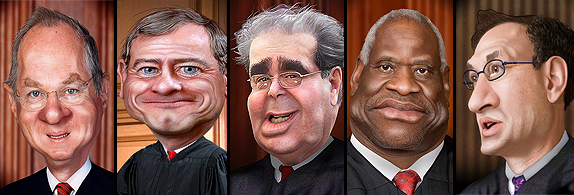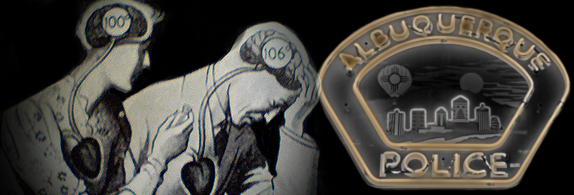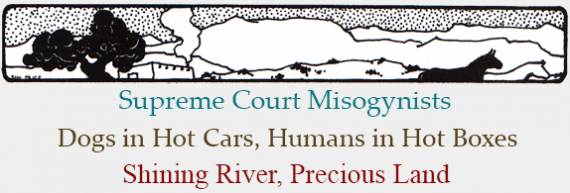Misogynists Against the Rest of Us

The conservative Republican majority of the Supreme Court, known to some of us as the Wall Street Court for considering corporations as people, gave women and anti-misogynist males the best reason possible this election season to do everything they can to promote voter turnout.
We know where the Right stands when it comes to women’s rights and basic issues of gender equality. They stand in the dungeon of ancient history. They believe women are unequal, inferior to men, that their physical health and access to social justice are secondary to the blood line and human property rights of the patriarchy which is embodied, most glaringly, in the five conservative male justices who voted in favor of letting Hobby Lobby squirm out of covering contraception under Obamacare on religious grounds.
If ever Democrats needed motivation to get out the vote, the Supreme Court’s decision in Burwell v. Hobby Lobby is it. If the conservatives take the Senate this year, Congress will be dominated by women haters. It’s that cut and dried. And that’s unbearable to contemplate.
And if the New Mexico House of Representatives goes Republican and Governor Martinez wins, our state will be on the verge of not only a corporate takeover of public institutions, not only an insurgency against public employee unions that might result in the worst case of union busting in the state’s history, we could also see religion-based anti-woman legislation here too.
After all, the governor mocked and questioned the role of the Commission on the Status of Women during her 2010 campaign. According to Mother Jones, Susana was caught on an audio recording asking about the Commission “What the Hell is that?” And what did a panel on women do all day. The Commission on the Status of Women was founded in l973 to work on ways to improve the health and safety of women and to lobby for legislation to ensure pay equity for women.
Gov. Martinez defunded, and effectively terminated, the Commission with a budgetary line item veto early in 2011. She had tried to pass legislation in the 2011 legislative session to abolish the commission, but failed owing to a Democratic majority in the New Mexico House.
Think the phrase “war on women” is a political hyperbole? Think again.
The five man majority on the U.S. Supreme Court thinks so little of women as human beings with full lives every bit as complicated as any man’s that with the Hobby Lobby decision they were willing to open the door to all kinds of corporate “religious persons” to wiggle out of all kinds of humanitarian laws merely on the basis of professing sincere beliefs in one dogma or another. That religious owners of companies can now opt out of the Affordable Care Act covering contraception costs for women employees while still, of course, paying for surgical contraception for men – vasectomies – and even paying for Viagra as a medical necessity, is not only fathomlessly unjust but ludicrous in the extreme.
Burwell v. Hobby Lobby is a serious, mean spirited anti-humanitarian assault on women’s health. In an impoverished state like New Mexico, the cost of contraception – especially the expensive, long term devices that actually work–can break a family financially and have horrendous implications for women whose health is undermined by other illnesses for which contraception can be a life and death necessity. When contraception is expensive financially strapped families often treat it as a luxury and go without it. And often the sorrow and misery of abortion becomes a necessity. As Justice Ruth Bader Ginsberg wrote in her 35 page dissent, “it bears note in this regard that the cost of an IUD (inter uterine device) is nearly equivalent to a month’s full-time pay for workers earning the minimum wage.” And IUDs have the best chance of working over all the other devices, including condoms.
“Should an employee of Hobby Lobby…share the religious beliefs of the (owners) she is of course under no compulsion to use the contraception in question,” Ginsberg wrote. Providing relatively inexpensive contraceptive devices to women has “a compelling interest in public health and woman’s well being. Those interests are concrete, specific, and demonstrated by a wealth of empirical evidence. To recapitulate, the mandated contraception coverage enables women to avoid the health problems unintended pregnancies may visit on them and their children.”
Burwell v. Hobby Lobby chains women to a second class status based on gender, a status in which their health and the well-being of their families, including existing children, is less important than the religious beliefs of the company bosses, who are, incidentally, usually men.
It’s called sexism, a sexism that uses religion as its tool. And the American voter has to work harder than ever to put a stop to it.
If blatant sexism can’t get out the vote, we should entertain the possibility that American democracy has been lobotomized.
In another first amendment case, which seems oddly like Citizens United v. Federal Election Commission which in 2010 lifted all restrictions on election spending from “corporate persons” on the grounds of freedom of speech, the Supreme Court decided last week in McCullen v. Coakley to strike down a Massachusetts law that put a 35 foot buffer zone around women’s health clinics to prevent harassment of patients by anti-abortion mud slingers and brow beaters on grounds of freedom of speech. (It goes almost without saying that if a woman sought counseling from anti-abortionists she could easily spot them 35 feet away and hear their views.)
In both Citizens United and McCullen, Supreme Court First Amendment absolutists protected the speech of bullies over the speech and expression of others.
I used to be a First Amendment absolutist until I realized that the freedom of speech clause was being used to promote the propaganda of vast corporations on the grounds that they are somehow “persons” and also to protect the vicious hate speech of bigots and racists without equal protection for those with little defense against it.
Speech that encroaches on or inhibits or drowns out the speech of others is speech that undermines the principle of freedom of speech, itself, enshrined in the First Amendment.
While the Court did not, in McCullen, rule out the possibility of buffer zones to protect women from the wrath of haters, some of them possibly terrorists who support murdering abortion providers and arson against health clinics, it does force women to endure the intolerable harassment and potential physical abuse, even to the point of critical injury, that anti-abortion protests have been known to instigate.
Until the Court decides on the proper limits of buffer zones, which could take years, McCullen allows the free speech of haters to bully and torment people for no other reason than they don’t agree with them.
So much for absolutism, which proves itself to be a close cousin of totalitarianism and authoritarianism.
Dogs in Hot Cars, Humans in Hot Boxes

Last week the Journal ran a passionate op-ed about the dangers of leaving dogs, not to mention children, locked up in cars with the windows closed on summer days. When it’s 75 degrees outside the inside of a parked car “can soar to 120 degrees in minutes, and on a 90-degree days, the interior temperature can reach 160 degrees in less than ten minutes,” author Lindsay Pollard-Post of the PETA Foundation wrote.
The irony struck us sharply when we first saw the piece. While it was about dogs, it had a graphic illustration of red faced human person under a hot sun seeming to be screaming in distress. In our minds the image still lingered of what happened to 13 peaceful protestors who occupied the Mayor’s lobby during an anti-police violence sit-in a few weeks ago. They were locked up in sweltering vans with the heaters on for some half an hour. The most gripping photograph of the incident shows an elderly woman emerging from the van with a scream forming on her face.
When it comes to dogs, the Journal op-ed was emphatic: “When temperatures warm up, no amount of time in a parked car is safe for dogs.”
It would be a sign of community health if we read such a remark under a strong headline about human beings!
Was the heat torture suffered by the sit-in demonstrators inflicted as part of a general APD policy? Is it a punitive custom no one really thinks about? Has this happened to many other people following a non-violent arrest? Or was it reserved specifically for “protesters” as a kind of instant political retribution?
Whatever the answer, this practice must stop.
Heat stroke can kill dogs and children in cars in a horrible way, with the brain becoming so dehydrated and the pain of the heat so intense that delirium and terrible panic takes them over before they lose consciousness and die.
The same is true for humans. And the older you get the less ease your body has in dissipating heat. The New York Times of June 23 this year ran a piece by Jane Brody which began “Hot weather kills more Americans than all other natural disasters combined and the casualties continue to climb despite decades of warnings about how to recognize the signs of heat stress and take prompt corrective action.”
Brody points out that heatstroke, or hyperthermia, is a rise in core body temperature to about 104. “The brain’s cerebellum is especially sensitive to heat, which explains the early signs of heatstroke: unsteady gait, confusion and disorientation.”
The protesters locked up in handcuffs in the overheated paddy wagons were put in real jeopardy of lethal hyperthermia by the APD officers who put them there and the leadership that sanctioned it.
Imagine if one of the persons protesting the killing of one of their relatives by the APD had died in those overheated vans, killed, themselves, for objecting to what the U.S. Justice Department calls the APD’s chronic use of unconstitutional lethal force.
Killing a dog in a hot car because of stupidity or irresponsibility is a tragedy. Killing a human being in a “hot box” van as a form of punitive prank or unofficial retribution by the police is an irredeemable personal calamity for the victim and his kin, and an unforgivable malicious crime on the part of people who are supposed to honor the law and protect us from those who would criminally do us harm.
One of these days I thoroughly expect to see in some mainstream media outlet a piece which reads in part: Hot boxes are really not all that hot and humans are bigger than dogs and can take more heat. And besides it was “justified.”
The whole thing just beggars the imagination.
Shining River, Precious Land

If you love Albuquerque and see more in it than a city crippled by crime and poverty and think it’s not just a strange hot place with a funny name but one of those cities with so many beautiful secrets it overcomes the harsh modern world everyday, you will love one of the classic works of Nuevo Mexicana published by the Albuquerque Museum in l986. It’s called Shining River, Precious Land: An Oral History of Albuquerque’s North Valley. Its authors, Mary Davis and the late Kathryn Sargeant, compiled stories about one of the agricultural heartlands of the Middle Rio Grande Valley, an area that extends from Old Town to Alameda and from Rio Grande to Edith.
In many ways it’s still one of the most agrarian and cosmopolitan parts of the city, full of wooded open space, large fields of various crops, grape orchards, elm and cottonwood arbored irrigation ditches, and a sense of peace and quiet that sometimes, at night, might be like it was in the 1930s. When we moved to the North Valley 45 years ago, the supermarkets still carried sheep’s heads and other delicacies for their tribal customers. You could see Fred Candelaria drive his tractor down Candelaria Boulevard and Ted Marchon tending his orchard. Pheasants roamed open fields in neighborhoods, horses crossed through your back yard, and one could walk in the moonlight along the ditches without any fear or trepidation.
That world is fading now. But pockets of it still exist, especially around the Duranes Lateral, the Griegos Drain, and other parts of the Middle Rio Grande Conservancy District’s irritation system and in the neighborhoods of Los Ranchos de Albuquerque. In Shining River, Precious Land, Davis and Sargeant interview the survivors and descendants of the North Valley from the era between WW I and WW II. They cover such topics as “country childhoods,” wakes, farm work and day labor, floods, the wine industry and prohibition, the hard times of the great depression, politics and denizens, tribal neighbors, and stories of life lived on the land with an abundant river that was both the source of life and a catastrophe just around the corner.
David Montoya told the authors, “When my grandfather came and saw the land, he fell down on his knees, and he was lifting up the dirt. He loved it. I think that never left him because the land was so good – he raised so much that he was able to feed all his family.” Those of us with our tiny garden farms can feel the same way when the compost, the weather, the worms, and the sunshine make everything just right.
Fiesta time in the North Valley was a kind of paradise for kids. “The fiestas were the big thing. If I got fifty cents to go to the fiesta, I was in ‘tall cotton’,” Jake Griego said. Fiestas were always centered around the patron saint of the community. “I remember there were greased poles that you had to climb and greased hogs you had to wrestle with – and the horse races and the dancing. The dancing always took place near the church. They would sell candy, ice cream, cold drinks. Everyone used to come in a horse and wagon,” Robert Gutierrez reminisced.
Luminarias on Christmas Eve were different long ago. Each house had nine of them in paper bags, welcoming the Christ child. Mela Koeber told Davis and Sargeant of the first years she lived on Guadalupe Trail in the l930s, it “was delightful because you would go up and down the Trail, you could go clear to Alameda, Corrales and all those rural areas including Edith Boulevard (which was then named La Ladera Road), and every house had its nine candles in paper bags, sometimes on the roof and sometimes just at the entrance to the house.”
The Depression was tough on the North Valley. But many people remember its camaraderie, its make do inventiveness and its generosity with particular relish. Patricia Montoya remembers “We never had problems because mother would dry chili and beans and mushrooms in abundance. They still ask the people in Corrales, ‘How are the mushrooms?’ They say it in Spanish to everyone who comes from Corrales because they figure that all they ate during the Depression was mushrooms. They grow in abundance in Corrales. They used to dry them, and they would sauté them a little bit with a little oil. They used to fix red chilies with mushrooms. They used mushrooms all the time.”
Shining River, Precious Land has hundreds of wonderful tales of a world that no longer exists as it did, but one you can still feel in the calm of the evening on ditch paths or around open fields. It’s one of Albuquerque’s great secrets and great joys.
(Image credits: Supreme Court Justice caricatures by DonkeyHotey, heat stroke diagram by weegeebored)




Responses to “Provincial Matters, 7-7-2014”